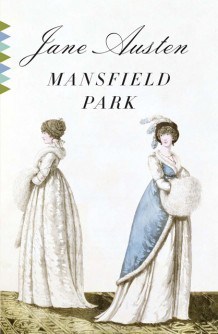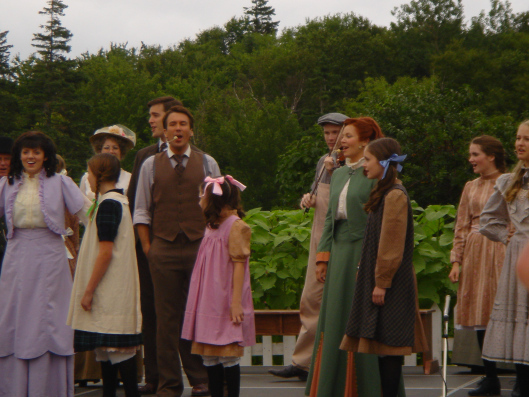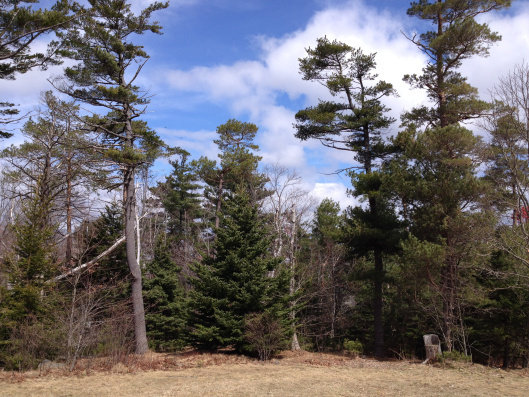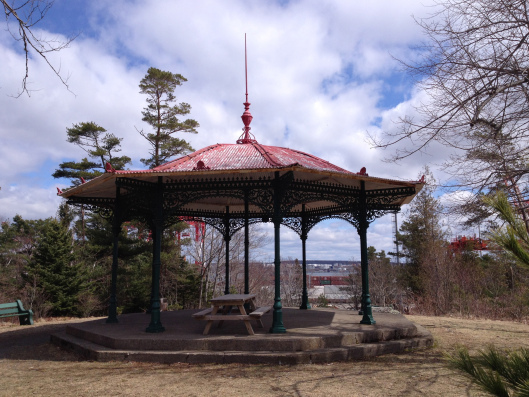Sarah Emsley's Blog, page 34
May 23, 2014
First Impressions of Fanny Price
Third in a series of posts celebrating 200 years of Mansfield Park. For more details, open Your Invitation to Mansfield Park.
Jennie Duke and I share a fascination with the way Jane Austen introduces Fanny Price as a child in the second chapter of Mansfield Park. We get a glimpse of Catherine Morland’s infancy and girlhood (though by the second paragraph of Northanger Abbey she’s fifteen), and we get to hear about the many reading lists Emma Woodhouse draws up for herself as a teenager, but we don’t get to read longer scenes from their childhoods or those of Austen’s other heroines. (What do you think Lady Susan would have been like at the age of ten – has anyone written that prequel yet?)
 Jennie and I are also both interested in the so-called “Jane-a-Day” five-year journal (“With 365 Witticisms by Jane Austen”), which provides a few blank lines for each day of the year so that if you write something every day, you’ll be able to look back and compare what you were doing every year on May 23rd, say, over the past five years. Jennie is doing a much better job than I am of keeping up this “delightful habit of journaling” (Northanger Abbey, Chapter 3) and she tells me she often records quotations relevant to what’s happening in her life. My own approach is more haphazard, and while I’ve sometimes made entries for a few weeks at a time over the last couple of years since my dear friend Lisa Doucet gave me this lovely journal, I’m sorry to report that I haven’t yet recorded anything for May 23rd.
Jennie and I are also both interested in the so-called “Jane-a-Day” five-year journal (“With 365 Witticisms by Jane Austen”), which provides a few blank lines for each day of the year so that if you write something every day, you’ll be able to look back and compare what you were doing every year on May 23rd, say, over the past five years. Jennie is doing a much better job than I am of keeping up this “delightful habit of journaling” (Northanger Abbey, Chapter 3) and she tells me she often records quotations relevant to what’s happening in her life. My own approach is more haphazard, and while I’ve sometimes made entries for a few weeks at a time over the last couple of years since my dear friend Lisa Doucet gave me this lovely journal, I’m sorry to report that I haven’t yet recorded anything for May 23rd.
Today, however, I can record that Jennie has written about Fanny Price’s childhood for “An Invitation to Mansfield Park,” so that I can look back on this day in the next few years as we celebrate 200 years of Emma, Persuasion, and Northanger Abbey. Jennie writes about Pride and Prejudice at The Bennet Sisters (for love) and is editor of Property Observer (for work and love). She’s based in Melbourne, Australia, and I’m happy to introduce her post on Fanny Price at age ten.
Fanny Price was at this time just ten years old, and though there might not be much in her first appearance to captivate, there was, at least, nothing to disgust her relations. She was small of her age, with no glow of complexion, nor any other striking beauty; exceedingly timid and shy, and shrinking from notice; but her air, though awkward, was not vulgar, her voice was sweet, and when she spoke her countenance was pretty.
- From Mansfield Park, Chapter 2 (London: Vintage, 2008)

Joan Hassall’s illustration of Edmund comforting young Fanny (from http://www.pemberley.com/janeinfo/jabrokil.html)
I can’t help but feel that this description of Fanny Price is very insulting – with “nothing to disgust,” “no glow,” the description is largely about what she is not. To be deficient in either “striking beauty” or captivating appearance clearly points out what other people value and suggests that she falls below some socially valued benchmark. For a heroine at the age of ten, this is some fairly hefty judgment indeed.
It’s a fascinating description because of everything it lacks, particularly when you compare it with the treatment of Austen’s other heroines. Emma Woodhouse, “handsome, clever and rich,” is clearly defined, with strong words. On the other hand, Fanny Price has no glow of complexion and is exceedingly timid and shy, and she shrinks from notice, but is able to be steadfast and strict about her ethics and beliefs in a way few other heroines are.
Austen’s decision to focus on Fanny at such a young age, ten years old, at a point when she has had little opportunity to learn or grow, is a bold one that she does not force upon her other heroines. Emma is brought to our notice during her twenties, fully formed and strong – although we later learn that she has been given responsibility from age twelve as mistress of the house. We also learn of Emma that “At ten years old she had the misfortune of being able to answer questions which puzzled her sister at seventeen.”
Other Austen heroines are usually described in relation to others and their family situations, and introduced with far less fanfare. Sarah has written about the way Austen introduces Elizabeth and other Pride and Prejudice characters, and she shows how slowly some of the information is revealed in that novel.
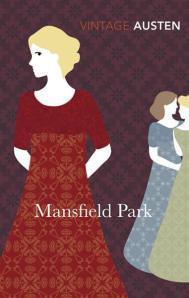 Which brings me back to Emma and Fanny, as they are described using the same technique, but to vastly different effect. Emma and Fanny are stark opposites in character, and yet Fanny, much like Emma, is largely alone. While Emma’s solitude is based on her higher position in life and independence from her father in his home, Fanny’s solitude is due to her entirely opposite situation and reliance on a household she has no place in.
Which brings me back to Emma and Fanny, as they are described using the same technique, but to vastly different effect. Emma and Fanny are stark opposites in character, and yet Fanny, much like Emma, is largely alone. While Emma’s solitude is based on her higher position in life and independence from her father in his home, Fanny’s solitude is due to her entirely opposite situation and reliance on a household she has no place in.
In the end, we are left wondering why she wasn’t described as Catherine Morland is, in Northanger Abbey: “No one who had ever seen Catherine Morland in her infancy would have supposed her born to be an heroine.” Jane Austen often suggests we shouldn’t judge anything at its first appearance. Where Emma appears confident and vibrant, we see her needing to take the longest journey of all the heroines, and where Fanny appears to be the most wilting and unattractive of all, she takes a shorter journey. She’s much stronger than Emma, even though that certainly isn’t apparent at first.
To read more about all the posts in this series, visit An Invitation to Mansfield Park .


May 16, 2014
Adopting Affection
Second in a series of posts celebrating 200 years of Mansfield Park. For more details, open Your Invitation to Mansfield Park.
 You’ll soon notice that many of the contributors to this series are from Dalhousie University in Halifax, Nova Scotia, where I was a graduate student. Lyn Bennett, who wrote last week’s post on the opening paragraph of Mansfield Park, was in the PhD program with me, for example. The other contributors with connections to Dalhousie and/or its near neighbour, the University of King’s College, are Maggie Arnold, John Baxter, Elizabeth Baxter, Hugh Kindred, and the author of today’s post, Judith Thompson. It was in one of Judith’s classes that I first fell in love with Jane Austen’s novels. I had read Pride and Prejudice and Northanger Abbey as a teenager, but it wasn’t until I read Sense and Sensibility and discussed it in this class that I saw just how brilliant Austen’s fiction is. Thanks, Judith!
You’ll soon notice that many of the contributors to this series are from Dalhousie University in Halifax, Nova Scotia, where I was a graduate student. Lyn Bennett, who wrote last week’s post on the opening paragraph of Mansfield Park, was in the PhD program with me, for example. The other contributors with connections to Dalhousie and/or its near neighbour, the University of King’s College, are Maggie Arnold, John Baxter, Elizabeth Baxter, Hugh Kindred, and the author of today’s post, Judith Thompson. It was in one of Judith’s classes that I first fell in love with Jane Austen’s novels. I had read Pride and Prejudice and Northanger Abbey as a teenager, but it wasn’t until I read Sense and Sensibility and discussed it in this class that I saw just how brilliant Austen’s fiction is. Thanks, Judith!
 Judith Thompson is a professor of English Romantic Literature at Dalhousie, official archivist of the John Thelwall Society, and a leader in the rapidly-growing field of Thelwall Studies. She’s the author of John Thelwall in the Wordsworth Circle: The Silenced Partner (Palgrave, 2012), (co) editor of Thelwall’s The Peripatetic (Wayne State, 2001) and The Daughter of Adoption (Broadview, 2013) and she’s currently editing the first modern edition of Thelwall’s Selected Poetry and Poetics. She says that while she’s devoted her research career to reviving the legacy of this radical romantic, “acquitted felon” and eccentric polymath, she also has a strong teaching interest in Romantic women’s writing, and offers classes in everything from poetic voice to postmodern fiction.
Judith Thompson is a professor of English Romantic Literature at Dalhousie, official archivist of the John Thelwall Society, and a leader in the rapidly-growing field of Thelwall Studies. She’s the author of John Thelwall in the Wordsworth Circle: The Silenced Partner (Palgrave, 2012), (co) editor of Thelwall’s The Peripatetic (Wayne State, 2001) and The Daughter of Adoption (Broadview, 2013) and she’s currently editing the first modern edition of Thelwall’s Selected Poetry and Poetics. She says that while she’s devoted her research career to reviving the legacy of this radical romantic, “acquitted felon” and eccentric polymath, she also has a strong teaching interest in Romantic women’s writing, and offers classes in everything from poetic voice to postmodern fiction.
I have a secret to confess. I’ve always liked Fanny Price, even though she is generally agreed to be the most tight-ass heroine of the most conservative novelist of the romantic era, whereas I’m passionately in love with one of that era’s most kick-ass revolutionaries, the radical activist and atheist John Thelwall. But I’m not really betraying him by writing this blog post, because I’ve always suspected that there’s more to Fanny, and her creator, than there appears. One need not turn Austen’s mousy heroine into a cheeky ironist (a la Patricia Rozema) or a sullen rebel (a la Billie Piper), to find something appealing in her introverted independence, unshakeable integrity and undemonstrative opposition to the follies of her cousins. One need only recognize that, like her author, she takes in a lot more than she lets on.
 Recently I had occasion to revisit the adopted daughter of the Bertram family, in order to help me contextualize an edition of Thelwall’s novel The Daughter of Adoption, published 13 years before Mansfield Park. And strangely I found much to compare between the two narratives. Though Thelwall’s Seraphina is an outspoken Wollstonecraftian Creole who challenges and overturns the slaveowning patriarchal system, and Austen’s Fanny is a cowering English country-mouse who seems content to submit to classbound hierarchies and traditional moral codes, both novels share several plot elements and even some characters with the same names and natures. Perhaps this is because both draw from a common source in Burney’s Evelina, though it is not impossible that Austen had read Thelwall’s Daughter: it was published under a pseudonym, and she read a lot more than she let on, too.
Recently I had occasion to revisit the adopted daughter of the Bertram family, in order to help me contextualize an edition of Thelwall’s novel The Daughter of Adoption, published 13 years before Mansfield Park. And strangely I found much to compare between the two narratives. Though Thelwall’s Seraphina is an outspoken Wollstonecraftian Creole who challenges and overturns the slaveowning patriarchal system, and Austen’s Fanny is a cowering English country-mouse who seems content to submit to classbound hierarchies and traditional moral codes, both novels share several plot elements and even some characters with the same names and natures. Perhaps this is because both draw from a common source in Burney’s Evelina, though it is not impossible that Austen had read Thelwall’s Daughter: it was published under a pseudonym, and she read a lot more than she let on, too.
But I’m getting ahead of myself; the purpose of this post is not to undertake a comparison, and far less to promote my edition of Thelwall (though of course you should all read The Daughter of Adoption, available in an accessible Broadview edition here). Instead it is to say a few words about my chosen passage, which provides the main impetus for the adoption plot of Mansfield Park, taking up the middle of Chapter 1. Here Mrs. Norris proposes that they do something to help her poor sister, “reliev[ing her] from the charge and expense of one child entirely out of her great number” by “undertak[ing] the care of her eldest daughter.” It is not easily excerpted, because it extends over several pages, in a debate (ever so proper but full of Austen’s ironies) that also introduces stiff Sir Thomas and his busybody sister-in-law. Here is the core of it:
Sir Thomas could not give so instantaneous and unqualified a consent. He debated and hesitated; — it was a serious charge; — a girl so brought up must be adequately provided for, or there would be cruelty instead of kindness in taking her from her family. He thought of his own four children, of his two sons, of cousins in love, etc.; — but no sooner had he deliberately begun to state his objections, than Mrs. Norris interrupted him with a reply to them all, whether stated or not.
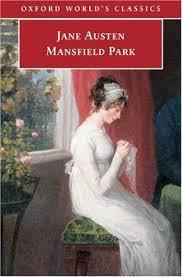 “My dear Sir Thomas, I perfectly comprehend you, and do justice to the generosity and delicacy of your notions, which indeed are quite of a piece with your general conduct; and I entirely agree with you in the main as to the propriety of doing everything one could by way of providing for a child one had in a manner taken into one’s own hands; and I am sure I should be the last person in the world to withhold my mite upon such an occasion. Having no children of my own, who should I look to in any little matter I may ever have to bestow, but the children of my sisters? – and I am sure Mr. Norris is too just – but you know I am a woman of few words and professions. Do not let us be frightened from a good deed by a trifle. Give a girl an education, and introduce her properly into the world, and ten to one but she has the means of settling well, without farther expense to anybody. A niece of ours, Sir Thomas, I may say, or at least of yours, would not grow up in this neighbourhood without many advantages. I don’t say she would be so handsome as her cousins. I dare say she would not; but she would be introduced into the society of this country under such very favourable circumstances as, in all human probability, would get her a creditable establishment. You are thinking of your sons – but do not you know that, of all things upon earth, that is the least likely to happen, brought up as they would be, always together like brothers and sisters? It is morally impossible. I never knew an instance of it. It is, in fact, the only sure way of providing against the connexion. Suppose her a pretty girl, and seen by Tom or Edmund for the first time seven years hence, and I dare say there would be mischief. The very idea of her having been suffered to grow up at a distance from us all in poverty and neglect, would be enough to make either of the dear, sweet-tempered boys in love with her. But breed her up with them from this time, and suppose her even to have the beauty of an angel, and she will never be more to either than a sister.”
“My dear Sir Thomas, I perfectly comprehend you, and do justice to the generosity and delicacy of your notions, which indeed are quite of a piece with your general conduct; and I entirely agree with you in the main as to the propriety of doing everything one could by way of providing for a child one had in a manner taken into one’s own hands; and I am sure I should be the last person in the world to withhold my mite upon such an occasion. Having no children of my own, who should I look to in any little matter I may ever have to bestow, but the children of my sisters? – and I am sure Mr. Norris is too just – but you know I am a woman of few words and professions. Do not let us be frightened from a good deed by a trifle. Give a girl an education, and introduce her properly into the world, and ten to one but she has the means of settling well, without farther expense to anybody. A niece of ours, Sir Thomas, I may say, or at least of yours, would not grow up in this neighbourhood without many advantages. I don’t say she would be so handsome as her cousins. I dare say she would not; but she would be introduced into the society of this country under such very favourable circumstances as, in all human probability, would get her a creditable establishment. You are thinking of your sons – but do not you know that, of all things upon earth, that is the least likely to happen, brought up as they would be, always together like brothers and sisters? It is morally impossible. I never knew an instance of it. It is, in fact, the only sure way of providing against the connexion. Suppose her a pretty girl, and seen by Tom or Edmund for the first time seven years hence, and I dare say there would be mischief. The very idea of her having been suffered to grow up at a distance from us all in poverty and neglect, would be enough to make either of the dear, sweet-tempered boys in love with her. But breed her up with them from this time, and suppose her even to have the beauty of an angel, and she will never be more to either than a sister.”
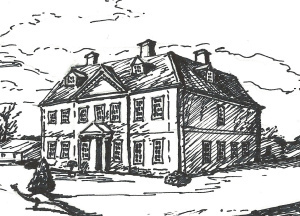 “There is a great deal of truth in what you say,” replied Sir Thomas, “and far be it from me to throw any fanciful impediment in the way of a plan which would be so consistent with the relative situations of each. I only meant to observe that it ought not to be lightly engaged in, and that to make it really serviceable to Mrs. Price, and creditable to ourselves, we must secure to the child, or consider ourselves engaged to secure to her hereafter, as circumstances may arise, the provision of a gentlewoman, if no such establishment should offer as you are so sanguine in expecting.”
“There is a great deal of truth in what you say,” replied Sir Thomas, “and far be it from me to throw any fanciful impediment in the way of a plan which would be so consistent with the relative situations of each. I only meant to observe that it ought not to be lightly engaged in, and that to make it really serviceable to Mrs. Price, and creditable to ourselves, we must secure to the child, or consider ourselves engaged to secure to her hereafter, as circumstances may arise, the provision of a gentlewoman, if no such establishment should offer as you are so sanguine in expecting.”
“I thoroughly understand you,” cried Mrs. Norris, “you are everything that is generous and considerate, and I am sure we shall never disagree on this point. Whatever I can do, as you well know, I am always ready enough to do for the good of those I love; and, though I could never feel for this little girl the hundredth part of the regard I bear your own dear children, nor consider her, in any respect, so much my own, I should hate myself if I were capable of neglecting her. Is not she a sister’s child? and could I bear to see her want while I had a bit of bread to give her? My dear Sir Thomas, with all my faults I have a warm heart; and, poor as I am, would rather deny myself the necessaries of life than do an ungenerous thing. So, if you are not against it, I will write to my poor sister tomorrow, and make the proposal; and, as soon as matters are settled, I will engage to get the child to Mansfield; you shall have no trouble about it. My own trouble, you know, I never regard. I will send Nanny to London on purpose, and she may have a bed at her cousin the saddler’s, and the child be appointed to meet her there. They may easily get her from Portsmouth to town by the coach, under the care of any creditable person that may chance to be going. I dare say there is always some reputable tradesman’s wife or other going up.”
– From Mansfield Park, Chapter 1 (New York: Oxford, 2008)
What no doubt strikes the modern reader is how little concern is shown for the emotional needs of the adoptee, as either a child or an individual (note, for instance, that her name is never mentioned). Sir Thomas at least begins by thinking about kindness to her, but this is undercut by self-interest and social propriety (what would be “consistent with the relative situations of each”). The word “love” is used only in relation to his immediate family, and betrays his intense class anxiety: one of his boys might violate social hierarchies by falling in love with his lowly cousin.
Mrs. Norris, on the other hand, despite her longwinded protestations, is motivated by nothing but financial self-interest; any words of emotion she uses (“generosity,” kind heart,” repeating Sir Thomas’ fear of “love”) are entirely insincere and calculated to flatter either him or herself. Although she may seem progressive in suggesting that it is important to “give a girl an education,” the only female independence she really cares about is her own freedom from responsibility. Her true attitude to her niece is neatly revealed, with typical Austen irony, at the end of each of her speeches. In the first of these she equates the unnamed child with an animal (“breed her up with them” is a devastating comment on Sir Thomas’ anxiety about good breeding). In the second she treats her like a package to be sent from Portsmouth “with any creditable person that may chance to be going” (here again the repetition of a word initially used by Sir Thomas reveals the bottom-line mentality that lies beneath the aristocratic facade).
Although such unfeeling calculation may be shocking to us, it is entirely consistent with what we know the history of adoption, which, surprisingly, was not actually legal in England until the 1920s. Before that, like Sir Thomas, English common law insisted upon the primacy of bloodlines, property and primogeniture. While informal adoptions and wardships like the ones being negotiated here had always existed, adoption was primarily a mechanism to gain advantage (whether cheap labour or moral credit) for the adopter, rather than a way of ensuring the adoptee’s well-being.
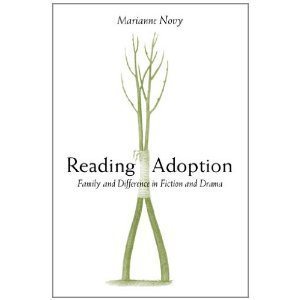 As Marianne Novy, chief historian of the English adoption novel, points out, the slow move towards more humanitarian adoption in England began with the institution of the London Foundling Hospital in the mid 18th century, closely connected to the development of the novel through the work of Henry Fielding, one of its sponsors. Fielding’s Tom Jones is of course the classic English adoption novel, whereby a foundling is taken in by a noble family, but always suspected of “bad blood” and ultimately cast out, until, after overcoming many obstacles (including various surrogate parents) he discovers that he really IS related by blood to his Allworthy father. In the case of the female bildungsroman, for example Fanny Burney’s Evelina, the adopted daughter is typically more timid and trammeled by social convention, but she endures and overcomes similar stigmas and surrogates before the novel ends with her aristocratic father “owning” her (a word whose dual meanings Burney exploits to highlight the tension between bonds of affection and mere financial obligations).
As Marianne Novy, chief historian of the English adoption novel, points out, the slow move towards more humanitarian adoption in England began with the institution of the London Foundling Hospital in the mid 18th century, closely connected to the development of the novel through the work of Henry Fielding, one of its sponsors. Fielding’s Tom Jones is of course the classic English adoption novel, whereby a foundling is taken in by a noble family, but always suspected of “bad blood” and ultimately cast out, until, after overcoming many obstacles (including various surrogate parents) he discovers that he really IS related by blood to his Allworthy father. In the case of the female bildungsroman, for example Fanny Burney’s Evelina, the adopted daughter is typically more timid and trammeled by social convention, but she endures and overcomes similar stigmas and surrogates before the novel ends with her aristocratic father “owning” her (a word whose dual meanings Burney exploits to highlight the tension between bonds of affection and mere financial obligations).
 It is that same tension between affection, economic self-interest and “noblesse oblige” that lies at the heart of the (heartless) exchange between Sir Thomas and Mrs. Norris, and defines the adoption plot of Mansfield Park. Fanny is a lot like Evelina: intimidated by the false, fashionable world of her adopted family, she is unable to assert herself even though she recognizes and resists its pretense. Yet ultimately, even more than Burney’s heroine, Fanny prevails: the great irony of the novel is that the lowly adopted daughter is more loyal to Sir Thomas than his dishonoured birth daughters, and he not only recognizes this but reorients his family around her.
It is that same tension between affection, economic self-interest and “noblesse oblige” that lies at the heart of the (heartless) exchange between Sir Thomas and Mrs. Norris, and defines the adoption plot of Mansfield Park. Fanny is a lot like Evelina: intimidated by the false, fashionable world of her adopted family, she is unable to assert herself even though she recognizes and resists its pretense. Yet ultimately, even more than Burney’s heroine, Fanny prevails: the great irony of the novel is that the lowly adopted daughter is more loyal to Sir Thomas than his dishonoured birth daughters, and he not only recognizes this but reorients his family around her.
Of course the meaning of that irony has been a matter of much debate. Does Austen use adoption to challenge and reform the aristocratic patriarchal family from below (as Easton suggests), or does it serve as a kind of organic Burkean grafting that strengthens the bloodline, thereby retrenching aristocratic privilege and power (as Tuite maintains)?
 This is not the place to engage such debate. I’ll simply end by returning to the importance of affection in this novel of adoption. Ultimately, all of Fanny’s inflexible integrity adds up to a strong preference for the one person (Edmund) who gives her what is so lacking in that opening passage. She simply, single-mindedly stands firm and waits until her affection can be reciprocated. Mutual love is her moral law, and by the end of the novel, the family adopts that law as its own.
This is not the place to engage such debate. I’ll simply end by returning to the importance of affection in this novel of adoption. Ultimately, all of Fanny’s inflexible integrity adds up to a strong preference for the one person (Edmund) who gives her what is so lacking in that opening passage. She simply, single-mindedly stands firm and waits until her affection can be reciprocated. Mutual love is her moral law, and by the end of the novel, the family adopts that law as its own.
Which brings me back to Thelwall. For it is here that Fanny is most like Thelwall’s heroine, Seraphina, who for all her independence and assertiveness, also withdraws from the deceptive, soul-destroying world of fashion, and holds firm, forcing another dysfunctional, slave-owning aristocratic family to reshape itself according to her unshakeable values, of which the chief is mutual affection. At the end of the novel she asserts the moral of the story: “they build a family indeed, good doctor, who bring them up in social equality and reciprocal love.” Austen might or might not agree with the social equality part, but when it comes to daughters of adoption, the demure conservative and the fiery radical come together under the banner of reciprocal love.
Sources:
Austen, Jane. Mansfield Park. New York: Oxford UP, 2008.
Easton, Fraser. “The Political Economy of Mansfield Park: Fanny Price and the Atlantic Working Class,” Textual Practice 12.3 (1998): 459-488.
Novy, Marianne. Reading Adoption: Family and Difference in Fiction and Drama. Ann Arbor: U Michigan P, 2004.
Thelwall, John. The Daughter of Adoption. Peterborough, Ont.: Broadview, 2012.
Tuite, Clara. Romantic Austen: Sexual Politics and the Literary Canon. Cambridge: Cambridge UP, 2002.
To read more about all the posts in this series, visit An Invitation to Mansfield Park .


May 9, 2014
Clarity and Complexity: Mansfield Park Begins
Happy 200th anniversary to Mansfield Park, published on this day in 1814. Mansfield Park is not as famous as Jane Austen’s “darling child” Pride and Prejudice, but it’s still beloved, and the celebrations are just beginning. Please join us here every Friday this year as we read the novel together – open “Your Invitation to Mansfield Park” for more details.
I’m very happy to introduce Lyn Bennett’s guest post on the opening paragraph of Mansfield Park. Lyn is an Associate Professor at Dalhousie University, where she teaches classes in rhetoric, writing, and close reading. As well as Women Writing of Divinest Things (Pittsburgh: Duquesne University Press, 2004), she has published numerous articles on topics rhetorical and literary, from public discourse in Interregnum England, to interdisciplinarity in literary studies, to the critical reception of Edith Wharton. (Hooray for Edith Wharton!) Her current research focuses on medicine, illness, and the 17th-century writer, considering the work of non-medical writers as well as the physicians who gave discursive shape to the profession that would come to dominate medicine by century’s end. She is also an avid gardener who likes the country almost as much as Jane Austen.
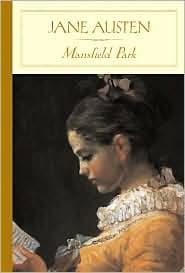 About thirty years ago Miss Maria Ward, of Huntingdon, with only seven thousand pounds, had the good luck to captivate Sir Thomas Bertram, of Mansfield Park, in the county of Northampton, and to be thereby raised to the rank of a baronet’s lady, with all the comforts and consequences of an handsome house and large income. All Huntingdon exclaimed on the greatness of the match, and her uncle, the lawyer, himself, allowed her to be at least three thousand pounds short of any equitable claim to it. She had two sisters to be benefited by her elevation; and such of their acquaintance as thought Miss Ward and Miss Frances quite as handsome as Miss Maria, did not scruple to predict their marrying with almost equal advantage. But there certainly are not so many men of large fortune in the world as there are pretty women to deserve them. Miss Ward, at the end of half a dozen years, found herself obliged to be attached to the Rev. Mr. Norris, a friend of her brother-in-law, with scarcely any private fortune, and Miss Frances fared yet worse. Miss Ward’s match, indeed, when it came to the point, was not contemptible: Sir Thomas being happily able to give his friend an income in the living of Mansfield; and Mr. and Mrs. Norris began their career of conjugal felicity with very little less than a thousand a year. But Miss Frances married, in the common phrase, to disoblige her family, and by fixing on a lieutenant of marines, without education, fortune, or connexions, did it very thoroughly. She could hardly have made a more untoward choice. Sir Thomas Bertram had interest, which, from principle as well as pride—from a general wish of doing right, and a desire of seeing all that were connected with him in situations of respectability, he would have been glad to exert for the advantage of Lady Bertram’s sister; but her husband’s profession was such as no interest could reach; and before he had time to devise any other method of assisting them, an absolute breach between the sisters had taken place. It was the natural result of the conduct of each party, and such as a very imprudent marriage almost always produces. To save herself from useless remonstrance, Mrs. Price never wrote to her family on the subject till actually married. Lady Bertram, who was a woman of very tranquil feelings, and a temper remarkably easy and indolent, would have contented herself with merely giving up her sister, and thinking no more of the matter; but Mrs. Norris had a spirit of activity, which could not be satisfied till she had written a long and angry letter to Fanny, to point out the folly of her conduct, and threaten her with all its possible ill consequences. Mrs. Price, in her turn, was injured and angry; and an answer, which comprehended each sister in its bitterness, and bestowed such very disrespectful reflections on the pride of Sir Thomas as Mrs. Norris could not possibly keep to herself, put an end to all intercourse between them for a considerable period.
About thirty years ago Miss Maria Ward, of Huntingdon, with only seven thousand pounds, had the good luck to captivate Sir Thomas Bertram, of Mansfield Park, in the county of Northampton, and to be thereby raised to the rank of a baronet’s lady, with all the comforts and consequences of an handsome house and large income. All Huntingdon exclaimed on the greatness of the match, and her uncle, the lawyer, himself, allowed her to be at least three thousand pounds short of any equitable claim to it. She had two sisters to be benefited by her elevation; and such of their acquaintance as thought Miss Ward and Miss Frances quite as handsome as Miss Maria, did not scruple to predict their marrying with almost equal advantage. But there certainly are not so many men of large fortune in the world as there are pretty women to deserve them. Miss Ward, at the end of half a dozen years, found herself obliged to be attached to the Rev. Mr. Norris, a friend of her brother-in-law, with scarcely any private fortune, and Miss Frances fared yet worse. Miss Ward’s match, indeed, when it came to the point, was not contemptible: Sir Thomas being happily able to give his friend an income in the living of Mansfield; and Mr. and Mrs. Norris began their career of conjugal felicity with very little less than a thousand a year. But Miss Frances married, in the common phrase, to disoblige her family, and by fixing on a lieutenant of marines, without education, fortune, or connexions, did it very thoroughly. She could hardly have made a more untoward choice. Sir Thomas Bertram had interest, which, from principle as well as pride—from a general wish of doing right, and a desire of seeing all that were connected with him in situations of respectability, he would have been glad to exert for the advantage of Lady Bertram’s sister; but her husband’s profession was such as no interest could reach; and before he had time to devise any other method of assisting them, an absolute breach between the sisters had taken place. It was the natural result of the conduct of each party, and such as a very imprudent marriage almost always produces. To save herself from useless remonstrance, Mrs. Price never wrote to her family on the subject till actually married. Lady Bertram, who was a woman of very tranquil feelings, and a temper remarkably easy and indolent, would have contented herself with merely giving up her sister, and thinking no more of the matter; but Mrs. Norris had a spirit of activity, which could not be satisfied till she had written a long and angry letter to Fanny, to point out the folly of her conduct, and threaten her with all its possible ill consequences. Mrs. Price, in her turn, was injured and angry; and an answer, which comprehended each sister in its bitterness, and bestowed such very disrespectful reflections on the pride of Sir Thomas as Mrs. Norris could not possibly keep to herself, put an end to all intercourse between them for a considerable period.
- From Mansfield Park, Chapter 1 (Kindle Edition)
Jane Austen’s third published novel doesn’t offer a platitudinous beginning like that so often quoted from her second. Begun while Austen was revising First Impressions to become Pride and Prejudice, Mansfield Park takes a different approach, opening with the comparatively tortuous “About thirty years ago, Miss Maria Ward, of Huntingdon, with only seven thousand pounds, had the good luck to captivate Sir Thomas Bertram, of Mansfield Park, in the county of Northampton, and to be thereby raised to the rank of a baronet’s lady, with all the comforts and consequences of an handsome house and large income.” Far from famous, Mansfield Park’s first line doesn’t offer the memorable simplicity of “It is a truth universally acknowledged, that a single man in possession of a good fortune, must be in want of a wife.”
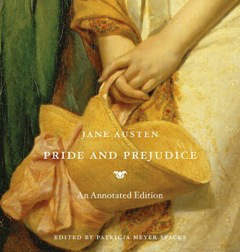 Like Pride and Prejudice’s, however, Mansfield Park’s beginning focuses on the elder generation and not the novel’s young protagonist. Yet the opening prominence of Fanny Price’s aunt resists conceding to her any more agency, either formally or substantively, than the Bertram women are willing to grant to their dependent niece and cousin. On the contrary, the future Lady Bertram proves an ineffectual actor not only in the novel but also in an opening sentence whose subject, “Miss Maria Ward,” lies far from the main and therefore finite verb “had.” Interrupting actor and action, the adjectivals “of Huntingdon” and “with only seven thousand pounds” focus our attention not on subject or verb but on incidentals presented in linked yet separate prepositional phases that do more to delay than enliven.
Like Pride and Prejudice’s, however, Mansfield Park’s beginning focuses on the elder generation and not the novel’s young protagonist. Yet the opening prominence of Fanny Price’s aunt resists conceding to her any more agency, either formally or substantively, than the Bertram women are willing to grant to their dependent niece and cousin. On the contrary, the future Lady Bertram proves an ineffectual actor not only in the novel but also in an opening sentence whose subject, “Miss Maria Ward,” lies far from the main and therefore finite verb “had.” Interrupting actor and action, the adjectivals “of Huntingdon” and “with only seven thousand pounds” focus our attention not on subject or verb but on incidentals presented in linked yet separate prepositional phases that do more to delay than enliven.
The details of Miss Maria Ward’s origins (the place whose inhabitants all “exclaimed on the greatness of the match”) and her fortune (which, in case of readers who may be unaware of relative monetary values some thirty years earlier, is “only seven thousand pounds”) serve both to fashion the subject and to defer the sentence’s notably weak verb. What Miss Maria Ward “had,” we learn, is the mere “good luck to captivate” Sir Thomas Bertram, the sentence’s grammatical object who is defined also by place and fortune. The novel’s beginning makes clear that this match succeeded not through intrinsic worth of character or decisive action, but by luck and circumstance.
Of this we are reminded again as the sentence’s subject becomes the object raised “to the rank of a baronet’s lady.” Mansfield Park may begin by offering Miss Maria Ward as actor and subject, but the most important information conveyed is not what she does. As we soon find out, the married Lady Bertram does very little, and Miss Maria Ward is the passive recipient of “all the comforts and consequences” attached to her elevation as Sir Thomas’s wife. The future wife may be the sentence’s subject, but the man who was once the captivated object becomes, as husband, the implied agent of its climactic action.
 Such grammatical and syntactic complexity is the hallmark of an introduction that traces a web of family relations not easily discerned. In form as well as content, Austen represents a complex social world in which a woman’s future depended on the match she made. Ideally, that match would raise a woman’s wealth or status (as with the lucky Miss Ward’s, whose union came about though she was “at least three thousand pounds short of any equitable claim”) while also recognizing norms and limitations (defiance of which, we discover, could produce frightening outcomes).
Such grammatical and syntactic complexity is the hallmark of an introduction that traces a web of family relations not easily discerned. In form as well as content, Austen represents a complex social world in which a woman’s future depended on the match she made. Ideally, that match would raise a woman’s wealth or status (as with the lucky Miss Ward’s, whose union came about though she was “at least three thousand pounds short of any equitable claim”) while also recognizing norms and limitations (defiance of which, we discover, could produce frightening outcomes).
Making this point through a series of complex and multi-clausal sentences, the introduction describes the nuptial fates of the two other Ward sisters, one of whom made a marriage not stellar but at least “not contemptible,” and one who “fared yet worse.” Notably, the former came to her “not contemptible” union (understatedly expressed by what it is not) after a twelve-year drought on the marriage market, at which time she “found herself obliged to be attached to the Rev. Mr. Norris,” while the latter “fared yet worse” through an action of her own, the wilful “fixing on a lieutenant of marines” that led her “to disoblige her family” in becoming the downwardly mobile Mrs. Price.
Lacking her sister Lady Bertram’s “very tranquil feelings, and a temper remarkably easy and indolent” or the benefits granted to the Reverend and Mrs. Norris by Sir Thomas, who was “happily able to give his friend an income in the living of Mansfield,” Frances Price pays not only in name but also in consequence for her failure properly to recognize social codes inseparable from familial obligation. Neglected by the indolent Lady Bertram and chastised by the busy Mrs. Norris, “Mrs. Price, in her turn, was injured and angry,” having learned little and persistently defiant in a letter “which comprehended each sister in its bitterness, and bestowed such very disrespectful reflections on the pride of Sir Thomas.” The result is “an end to all intercourse between them for a considerable period,” and the end to an introduction that may be as deliberately distracting as it is verbose.
What her sisters fail to recognize as they variously ignore, ostracize, and condemn poor Mrs. Price is what the attentive reader should. Though overshadowed by the details of the family’s busy history, the sentiment is crystal clear: despite all of Huntingdon’s hopes, the narrator insists, “there certainly are not so many men of large fortune in the world as there are pretty women to deserve them.” Austen thus answers Pride and Prejudice’s famous first line with a platitude that proves ironic both within Mansfield Park and between it and the earlier novel. In a world that offered little to women outside of making an advantageous match, this may be the narrator’s and the novel’s most important point. Obscured yet available from its very beginning, then, is Mansfield Park’s vital lesson – that the simple clarity we later learn to associate with Fanny Price may offer truths we would do well to acknowledge.


May 7, 2014
The Great Novels of 1814: Austen, Burney, Edgeworth and Scott
As part of the celebrations for the 200th anniversary of Jane Austen’s Mansfield Park, I’m delighted to share with you a guest post from Jacqui Grainger, former Librarian at Chawton House Library. Here’s Jacqui’s report on a recent symposium held at the University of Sydney, where she is currently Manager of Rare Books and Special Collections. Here’s your “Invitation to Mansfield Park.“ I hope you’ll join us again on Friday — the big day! — for Lyn Bennett’s post on the opening paragraph of the novel.
One of the many events this year to celebrate the bicentenary of the publication of Austen’s Mansfield Park was the symposium held on the 16 April in the University of Sydney’s Fisher Library. It was a wonderful way to celebrate my first, and very busy, eight months in my new post as the Manager of Rare Books and Special Collections at the University Library and it was a fantastic complement to the exhibition of Great Novels of 1814 that I had curated. The Library’s copy of the first edition of Mansfield Park requires conserving and I thought there would be no better way of highlighting its plight and launching a fundraising campaign.
The symposium celebrated the works of Austen’s contemporaries published the same year: Frances Burney’s The Wanderer, Maria Edgeworth’s Patronage and Walter Scott’s Waverley – all writers she admired. The timetable for the day was varied but several themes were echoed throughout the papers presented. We began with an introduction by the Symposium Chair, Professor Margaret Harris of the University of Sydney. Margaret had been instrumental in the Library’s acquisition of the collection of long nineteenth century novels in the 1980s in which those under discussion are held. The papers given are listed and summarised below:

Sir Walter Scott, Image from Novels 1780-1920, Rare Books and Special Collections, University Library, University of Sydney
Framing the Past: Walter Scott’s Waverley and the Composition of History – Professor Will Christie, of the University of Sydney, which discussed Scott’s fascination with the past. It considered this fascination as a miracle of eclecticism, as a past that is both multi-modal and multi-valent, in how it informs the present and Scott’s interest in periods of conflict. In Waverley, set in the Jacobite uprising of 1745, the closer Edward Waverley and the reader get to the Highlands the more corrupted it becomes. Scott, as a rational lawyer, in his cultural anatomising of Scotland depicts MacIvor, the clan chief, as a charismatic feudal ruler in direct conflict with the tenets of the Enlightenment. The success of Waverley – Austen in one of her letters commented on how Scott could have left novel writing to novelists like her – accelerated the Tartan Rage, the fashion for the trappings of Scottishness, and ultimately the adoption of the Highlanders’ kilt as a Scottish symbol. Scott also stage-managed George IV’s visit to Edinburgh which as a pageant, along with Sir David Wilkie’s portrait of George IV dressed in Stewart tartan, emphasised the Hanovarian king as also the Scottish king. Scott was awarded with a baronetcy for this and in Edinburgh he got the largest memorial of any writer: he pleased everyone.
Invasion and Resistance in the novels of 1814: Jacobins, Jacobites, jabs and Jocks – Dr Olivia Murphy, of Murdoch University, Perth, discussed invasion plots and how in these novels of 1814 the fear of invasion was not at all quick in passing. There were twenty years of conflict between Britain and France and the paper proposed that the anticipation of the end of warfare produced a creative release. In Waverley Edward invades his own country under the banner of Bonnie Prince Charlie. The Highlands are romanticised but the Highlanders are seen as ‘sauvage’. In Patronage the loss of Percy Hall and its temporary possession by upstarts is resisted and it is ultimately restored to its rightful, morally steady owners, the Percy family. We can see a similar pattern in The Wanderer with Juliet’s flight from her Jacobin French husband who is finally repulsed with English cash. In Mansfield Park too, dangerous invaders are repulsed. The Crawford siblings are first resisted by Fanny and finally by the majority of the family. The danger they represent though is clearly shown by Maria’s fate.
‘Ovid was a mere fool to you’: Clothing and nationality in The Wanderer – Dr Stephanie Russo, Macquarie University, Sydney (and co-organiser of the symposium), begins by considering Juliet as a ‘shape-shifter’. From the beginning of the novel the characters around her all find it hard to understand who she is. Her racial identity is questioned and she appears in various disguises – poor or rich, seamstress or lady – and she does not convince people that she will not change again. Elinor Jodrell, who befriends Juliet early on, uses her clothes to reconstruct herself as a radical Wollstonecraftian figure: shabby, ghost-like, foreign, man-like and suicidal persona. Both women at times illustrate how clothing and patriotism can become aligned.
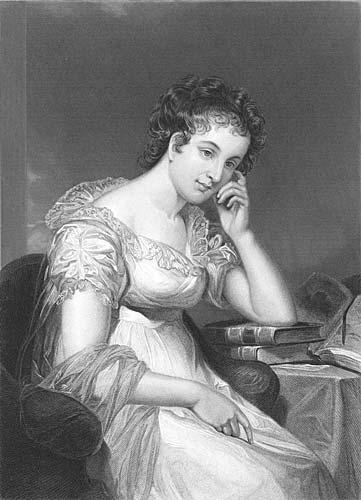
Maria Edgeworth, Image from Novels 1780-1920, Rare Books and Special Collections, University Library, University of Sydney
Maria Edgeworth’s youthful influence on Sir Walter Scott’s Waverley – Dr Ryan Twomey, of Macquarie University, Sydney, presented a paper that acknowledged how Edgeworth’s work enabled Scott to discuss race and national identity. He also raised the issue that Scott in turn had a profound effect on the young George Eliot who was given Waverley to read at the age of eight. Indeed Scott becomes the link, or pivot point, between two women writers whose juvenilia was seminal to the writers they became. Scott’s work was vastly influential around the world and he acknowledged the influence of Edgeworth – the two became warm supporters of each other – in the new generic conventions he became associated with: the regional novel and the historical novel. From his reading of her work he appreciated her ‘Irishisms’ and looked at how she presented her characters’ individual voices, applying these ideas to his own work. The effect of this on the young George Eliot is clear in her juvenilia and in turn informs the development and progression of her adult narratives.
Jane Austen’s revision in proof to Mansfield Park (1814): a speculation – Professor Jocelyn Harris, University of Otago, Dunedin, discussed close parallels between Mansfield Park, Patronage and The Wanderer leading to speculation on last minute editing by Austen of her novel after reading the other two. It is known from Austen’s letters that she had great admiration for both the other novelists. She may too have had access to Burney’s printer through her brother Henry and here there can be some speculation that she got hold of an advance copy; 8000 copies of Patronage sold the first day of publication and there remains a copy in what was her brother’s library, the Knight Collection at Chawton House Library. There is no proof she read this copy but it shows she had access to one – it contains a copy of The Wanderer as well (from 2007-2013 I was the librarian at Chawton House Library). If she did integrate aspects of the other two novels and respond to these two authors we can now see, too, a process of readership, response and ongoing discourse that sculpts Mansfield Park until the very last moment possible.
The day ended with a talk, private view and guided tour of the exhibition The Great novels of 1814: Austen, Burney, Edgeworth and Scott. The Austen aspect of the exhibition will be described in an additional entry to An Invitation to Mansfield Park.


May 2, 2014
“I have something in hand…” ~ The Publishing of Jane Austen’s Mansfield Park
Jane Austen’s Mansfield Park was published two hundred years ago this month, on May 9, 1814. To begin the celebrations, here’s a wonderful, and beautifully illustrated, account of the publication history of the novel by Deborah Barnum of Jane Austen in Vermont. Thanks, Deb!
Please join us for more Mansfield Park posts this month and throughout 2014. Next Friday, Lyn Bennett will discuss the opening paragraph of the novel.
 Originally posted on Jane Austen in Vermont:
Originally posted on Jane Austen in Vermont:
I have something in hand – which I hope on the credit of P. & P. will sell well, tho’ not half so entertaining.(Ltr. 86: 3 – 6 July 1813, to Capt. Francis Austen)
*****************
Dear Gentle Readers: This history of the publishing of Mansfield Park serves as an introduction to Sarah Emsley’s series “An Invitation to Mansfield Park,” which will begin on May 9th on her blog. As we celebrate this bicentenary of Austen’s third novel, published in May 1814, it seems only right to begin at the beginning, from when Austen first makes mention of Mansfield Park in her letters and its subsequent road to publication, to the later printings and early illustrated works. I am posting it here because of its length and number of illustrations – and Sarah will be re-blogging it immediately. Please continue to visit her blog for the interesting posts she…
View original 4,244 more words


April 25, 2014
A “blinding flash of illumination”
Third in a series of three posts on “Anne of Green Gables in Point Pleasant Park.” Here’s Part One, “Anne of Green Gables Loves Point Pleasant Park,” and here’s Part Two, “Gilbert Would Never Compose a Sonnet to My Eyes.”
In Anne of the Island, Roy Gardner writes sonnets about Anne Shirley, but Gilbert Blythe laughs when she tells him something funny and Roy doesn’t. Anne wonders “uneasily if life with a man who had no sense of humor might not be somewhat uninteresting in the long run.” I like how the syntax of that line reflects her convoluted thinking. Life with a man who can’t laugh might be dull. The phrasing “might not be somewhat uninteresting in the long run” is lovely in its awkwardness. She’s still trying to persuade herself that Roy is the right man: “who could expect a melancholy, inscrutable hero to see the humorous side of things? It would be flatly unreasonable.”
She’s still trying when Roy proposes. Where does he propose? In the park, of course: “Roy asked Anne to marry him in the little pavilion on the harbor shore where they had talked on the rainy day of their first meeting. Anne thought it very romantic that he should have chosen that spot.”
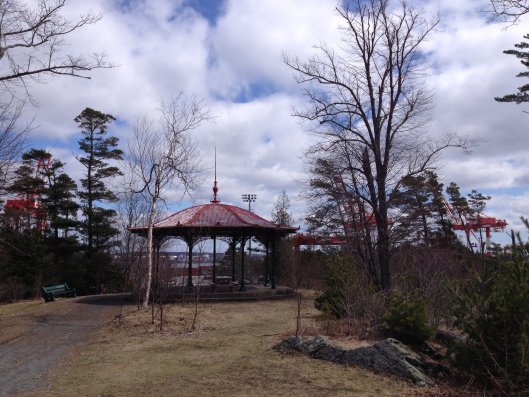
One of the two pavilions in Point Pleasant Park
Readers who know what Montgomery thought of Halifax (“the grimiest city in Canada”) know better than to think any proposal in any setting in this town could be acceptable to her Island heroine (even if Anne was born in Nova Scotia and is technically a “Come-from-Away” on the Island). Montgomery doesn’t tell us exactly what Roy says, but “it was as beautifully worded as if he had copied it, as one of Ruby Gillis’ lovers had done, out of a Deportment of Courtship and Marriage.” Anne recognizes that her response is not what it should be: she “felt that she ought to be thrilling from head to foot. But she wasn’t; she was horribly cool.”
She prepares to say “her fateful yes,” but she can’t do it. A “blinding flash of illumination” shows her that she can’t (readers of Jane Austen’s Emma might say “it darted through her, with the speed of an arrow”). And Montgomery does give us her words: “Oh, I can’t marry you – I can’t – I can’t” (readers of Austen’s Mansfield Park might think of Fanny Price – or of King Lear – “no, no, no”; “never, never, never”).
When Roy leaves, having told her she has ruined his life, Anne sits “for a long time in the pavilion, watching a white mist creeping subtly and remorselessly landward up the harbor. It was her hour of humiliation and self-contempt and shame. Their waves went over her. And yet, underneath it all, was a queer sense of recovered freedom.” There’s no mention of those beloved pines in this passage; presumably Anne doesn’t need comfort from the trees, because despite her feeling of shame, and disappointment in herself, she isn’t sorrowful. Maybe that white mist represents the fog that has concealed her true feelings about Roy.
At the very end of the novel, Gilbert proposes a second time (rather like Mr. Darcy proposing to Elizabeth Bennet for the second time at the end of Pride and Prejudice – and yes, I do link almost everything I read back to Jane Austen in some way, but I’m not imagining the connection between Anne and Gilbert and Elizabeth and Darcy. See Miriam Rheingold Fuller’s essay “Jane of Green Gables: L.M. Montgomery’s Reworking of Austen’s Legacy”). Significantly, he and Anne aren’t in Kingsport/Halifax anymore, but back at home in Avonlea. There’s no romantic rain, no pretty pavilion, no white mist. They walk through the woods together to visit a garden (Hester Gray’s garden, a hidden, neglected place that Anne and Diana Barry and their friends discovered long ago, in Anne of Avonlea, the garden of a young woman from Boston who died only a few years after she married).
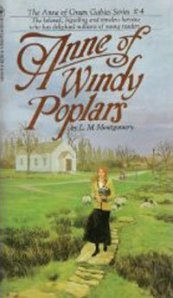 In this proposal, we do get to hear Gilbert’s words. He asks if Anne has “any unfulfilled dreams,” and, after listening to her reply about unfulfilled dreams in general – “It wouldn’t do for us to have all our dreams fulfilled” – he tells her of his very specific dream: “I persist in dreaming it, although it has often seemed to me that it could never come true. I dream of a home with a hearth-fire in it, a cat and a dog, the footsteps of friends – and you!”
In this proposal, we do get to hear Gilbert’s words. He asks if Anne has “any unfulfilled dreams,” and, after listening to her reply about unfulfilled dreams in general – “It wouldn’t do for us to have all our dreams fulfilled” – he tells her of his very specific dream: “I persist in dreaming it, although it has often seemed to me that it could never come true. I dream of a home with a hearth-fire in it, a cat and a dog, the footsteps of friends – and you!”
This time, it isn’t humiliation, self-contempt, or shame, but “happiness” that “was breaking over [Anne] like a wave. It almost frightened her.” Gilbert continues, “I asked you a question over two years ago, Anne. If I ask it again will you give me a different answer?” What does she say? Nothing – she answers him by looking at him with love, and then they talk over the misunderstandings of the past, and begin to make plans for their future together.
And what is immediately ahead of them? He tells Anne he has to ask her to wait a long time while he completes his medical training, and she says the waiting doesn’t matter. “We’ll just be happy, waiting and working for each other – and dreaming.”
Gilbert is headed back to Kingsport/Halifax and the medical school there – a.k.a. Dalhousie Medical School….
Previous posts on L.M. Montgomery and Halifax:
Point Pleasant Park as a Cure for Homesickness
Anne of Green Gables in Kingsport/Halifax
Anne of Green Gables Loves Point Pleasant Park
“Gilbert Would Never Compose a Sonnet to My Eyes”


April 24, 2014
“Gilbert Would Never Compose a Sonnet to My Eyes”
Second in a series of three posts on “Anne of Green Gables in Point Pleasant Park.” Read Part One here. Watch for Part Three tomorrow.
Anne Shirley and her friends do find the perfect house to live in while studying at Redmond College (Dalhousie University) in Kingsport (Halifax): Patty’s Place, a small house near the park, on a street that boasts many houses much larger and much grander. (You can read more about Patty’s Place and “Spofford Avenue,” inspired by Young Avenue, in “L.M. Montgomery’s Halifax: The Real Life Inspiration for Anne of the Island,” by Sue Lange, in The Shining Scroll, the newsletter for the L.M. Montgomery Literary Society.)
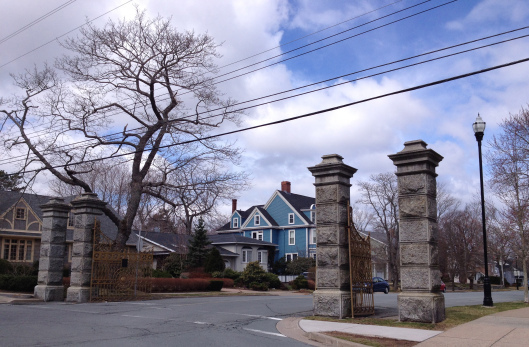
Young Avenue
Gilbert Blythe proposes, Anne rejects him, and not long after that, she meets Royal Gardner for the first time on “a gray day in the windy park.” Her umbrella has blown inside out and he offers his. “Tall and handsome and distinguished-looking – dark, melancholy, inscrutable eyes – melting, musical, sympathetic voice – yes, the very hero of her dreams stood before her in the flesh. He could not have more closely resembled her ideal if he had been made to order.” He suggests that they wait out the rain under the shelter of the pavilion, which gives them nearly an hour of conversation, and before long Anne begins to think he might really be the hero she’s dreamt of.
It isn’t surprising that Anne spends more time in the park than in Old St. John’s cemetery, given that she loves trees so much. On one of her visits with her friends, “The girls wandered down a long pineland aisle that seemed to lead right out into the heart of a deep-red, overflowing winter sunset.” Philippa finds the walk so inspiring, she wishes she knew how to write a poem. “It’s all so wonderful here – ” she says, “this great, white stillness, and those dark trees that always seem to be thinking.”
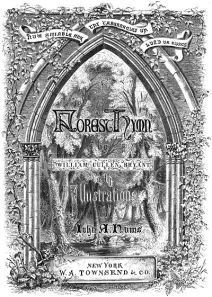 Instead of writing a poem, Anne quotes – well, misquotes – the first line of William Cullen Bryant’s 1824 poem “A Forest Hymn” in reply: “‘The woods were God’s first temples,’” adding “One can’t help feeling reverent and adoring in such a place. I always feel so near Him when I walk among the pines.” (The first line of the poem is “The groves were God’s first temples.”) On this walk, Philippa tells Anne about her engagement, and her question about whether Anne is going to marry Roy Gardner prompts Anne to think carefully about both Roy and Gilbert. Roy, who wrote a poem for her on her birthday – “very good stuff of its kind”; “very tolerable magazine verse” about eyes like stars and lips “redder than the roses of Paradise” – and Gilbert, who “would never have dreamed of writing a sonnet to her eyebrows.”
Instead of writing a poem, Anne quotes – well, misquotes – the first line of William Cullen Bryant’s 1824 poem “A Forest Hymn” in reply: “‘The woods were God’s first temples,’” adding “One can’t help feeling reverent and adoring in such a place. I always feel so near Him when I walk among the pines.” (The first line of the poem is “The groves were God’s first temples.”) On this walk, Philippa tells Anne about her engagement, and her question about whether Anne is going to marry Roy Gardner prompts Anne to think carefully about both Roy and Gilbert. Roy, who wrote a poem for her on her birthday – “very good stuff of its kind”; “very tolerable magazine verse” about eyes like stars and lips “redder than the roses of Paradise” – and Gilbert, who “would never have dreamed of writing a sonnet to her eyebrows.”
 At this point in rereading Anne of the Island, I got one of the songs from “Anne and Gilbert: The Musical” stuck in my head: “Gilbert Would Never Compose a Sonnet to My Eyes.” You can listen to part of the song here. The musical is wonderful, and if you happen to be in Charlottetown this summer, you should definitely go to this one (as well as to the more famous, long-running “Anne of Green Gables: The Musical” at the Confederation Centre for the Arts). Even if you aren’t in PEI this summer, you can buy the songs or the whole album (and no, no one’s paying me to promote any of this!).
At this point in rereading Anne of the Island, I got one of the songs from “Anne and Gilbert: The Musical” stuck in my head: “Gilbert Would Never Compose a Sonnet to My Eyes.” You can listen to part of the song here. The musical is wonderful, and if you happen to be in Charlottetown this summer, you should definitely go to this one (as well as to the more famous, long-running “Anne of Green Gables: The Musical” at the Confederation Centre for the Arts). Even if you aren’t in PEI this summer, you can buy the songs or the whole album (and no, no one’s paying me to promote any of this!).
I especially recommend “Gilbert Loves Anne of Green Gables” and “You’re Island Through and Through” (“If you mind your business and you mind your neighbour’s, too, you’re Island, you’re Island through and through”). And I love the line from Gilbert’s “Saturday Morning” about “marking papers” – the tone in which he says that line takes me right back to my long days, and nights, of marking essays. I saw “Anne and Gilbert” in Summerside during the summer of 2011 and I’d love to see it again. Here’s a photo of the cast performing “You’re Island Through and Through” – on a temporary stage in front of Green Gables itself.
Stay tuned for tomorrow’s post, Part Three of “Anne of Green Gables in Point Pleasant Park.”
Previous posts on L.M. Montgomery and Halifax:
“Point Pleasant Park as a Cure for Homesickness”
“Anne of Green Gables in Kingsport/Halifax”
“Anne of Green Gables Loves Point Pleasant Park”


April 23, 2014
Anne of Green Gables Loves Point Pleasant Park
Early in Anne of the Island, Anne Shirley and Gilbert Blythe go for a walk in Point Pleasant Park with a few friends. L.M. Montgomery doesn’t call the park “Point Pleasant,” but neither does she give it a new name, in the way that she fictionalizes Halifax as Kingsport and Dalhousie University as Redmond College. It’s simply “the park,” recognizable as Point Pleasant because of its shore road and its view of the small, treeless island in the harbour – George’s Island, here named “William’s Island.”
“Gilbert and Anne loitered a little behind the others, enjoying the calm, still beauty of the autumn afternoon under the pines of the park, on the road that climbed and twisted around the harbour shore.” The two of them are good friends at this point, but Gilbert is beginning to indicate he’d like to be more than friends. Montgomery herself sought solace in this park when she was unhappy, and Anne similarly claims, “if ever any great sorrow came to me, I would come to the pines for comfort.” Gilbert replies, “If I had my way I’d shut everything out of your life but happiness and pleasure, Anne” – and he says this “in the tone that meant ‘danger ahead.’”
Anne cuts the conversation short and they rejoin the others in a “little pavilion,” from which they “watch an autumn sunset of deep red fire and pallid gold.” Here’s a picture of one of the old pavilions in Point Pleasant, from which the view is similar to what Montgomery describes in the novel – although I think it would be hard to see the sentry Anne’s friend Philippa spots on the island, standing “on the summit of the fort, right beside the flag.”
She thinks he looks “as if he had stepped out of a romance.” But of course, in fiction Montgomery can put the pavilion wherever she wants to, and make the island closer to the park.

Looking towards the mouth of the harbour from the pavilion
To their left lay Kingsport, its roofs and spires dim in their shroud of violet smoke. To their right lay the harbor, taking on tints of rose and copper as it stretched out to the sunset. Before them the water shimmered, satin smooth and silver gray, and beyond, clean shaven William’s Island loomed out of the mist, guarding the town like a sturdy bulldog. Its lighthouse beacon flared through the mist like a baleful star, and was answered by another in the far horizon.
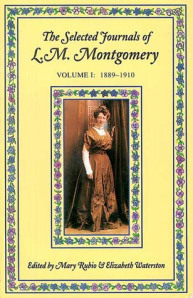 Later in the novel, when Anne and her friends are looking for a house to rent, they visit the park again “on one of April’s darling days of breeze and blue,” with Anne insisting she won’t worry about finding the right place “just now,” because worry will “spoil this lovely afternoon.” The narrator uses almost exactly the same words Montgomery used in her journal when she described her March 15, 1902 walk in Point Pleasant: “The fresh chill air was faintly charged with the aroma of pine balsam, and the sky above was crystal clear and blue – a great inverted cup of blessing.” Here’s what she says in the journal: “The fresh, chill spring air was faintly charged with the aroma of pine balsam and the sky over me was clear and blue – a great inverted cup of blessing.”
Later in the novel, when Anne and her friends are looking for a house to rent, they visit the park again “on one of April’s darling days of breeze and blue,” with Anne insisting she won’t worry about finding the right place “just now,” because worry will “spoil this lovely afternoon.” The narrator uses almost exactly the same words Montgomery used in her journal when she described her March 15, 1902 walk in Point Pleasant: “The fresh chill air was faintly charged with the aroma of pine balsam, and the sky above was crystal clear and blue – a great inverted cup of blessing.” Here’s what she says in the journal: “The fresh, chill spring air was faintly charged with the aroma of pine balsam and the sky over me was clear and blue – a great inverted cup of blessing.”
The 1985 edition of The Selected Journals of L.M. Montgomery, Volume I: 1889-1910, edited by Mary Rubio and Elizabeth Waterston, didn’t include that lovely March 15th journal entry about Point Pleasant, which is part of why it’s so great that Rubio and Waterston are now editing The Complete Journals of L.M. Montgomery. If I hadn’t read the second volume of The Complete Journals – The PEI Years, 1901-1911, I wouldn’t have seen the connection between the novel and the journal. Rubio and Waterston don’t footnote the examples of Montgomery drawing on her journals in her fiction, likely because it happens so often. I’d be interested to read more about this topic, so if any of you have suggestions for books or essays on links between the journals and the novels – or on the role of Halifax in Montgomery’s fiction – please send them my way.
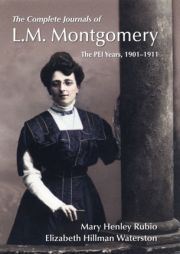 You can read my review of The Complete Journals – The PEI Years, 1901-1911 in the Fall 2013 issue of Atlantic Books Today on page 33.
You can read my review of The Complete Journals – The PEI Years, 1901-1911 in the Fall 2013 issue of Atlantic Books Today on page 33.
This is Part One of three posts on “Anne of Green Gables in Point Pleasant Park.” I’ll post Part Two, “Gilbert Would Never Compose a Sonnet to My Eyes,” tomorrow and Part Three, “A ‘blinding flash of illumination’” on Friday.
Previous posts on L.M. Montgomery and Halifax:
“Point Pleasant Park as a Cure for Homesickness”
“Anne of Green Gables in Kingsport/Halifax”


April 17, 2014
Celebrate 200 Years of Mansfield Park with JASNA Nova Scotia
The next JASNA Nova Scotia meeting is on Sunday, May 4th at 2pm. We’re venturing outside the Halifax area – hooray! – and we’re meeting at Catherine Morley’s house in the beautiful town of Hantsport. Let me know (by leaving a comment below) if you’re interested in attending and need directions.

Blue Beach, near Hantsport, NS
I’ll be speaking on one of my favourite topics: “Why Mansfield Park is a Tragedy,” and leading a discussion of the novel, especially its famous “Let other pens dwell on guilt and misery” ending. You can read about why I think it’s a tragedy in this post I wrote a couple of months ago.
And then on May 9th, you can read Lyn Bennett’s guest post on the opening paragraph of Mansfield Park on the blog. If you haven’t received it yet, you can find “Your Invitation to Mansfield Park” here.
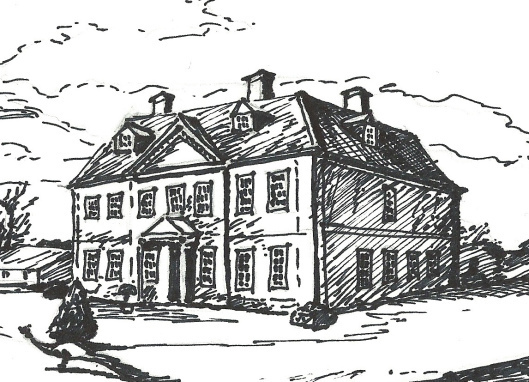
An Invitation to Mansfield Park
I love this novel and I’m excited about discussing it with JASNA NS in person and with all of you on-line. Next week, I’ll write more about Anne of Green Gables and Halifax, and then it’s on to the Mansfield Park celebrations!


April 15, 2014
A Visit to Henry James’s House
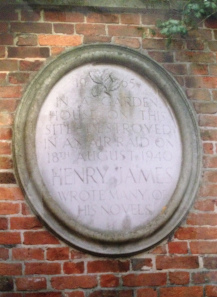
The wall around the garden at Lamb House. “In a garden house on this site – destroyed in an air raid on 18th August 1940 Henry James wrote many of his novels”
Henry James was born 171 years ago today, on April 15, 1843, and in honour of the occasion, I’d like to share with you an essay my dear friend Michèle Mendelssohn wrote about her first visit to James’s house in Rye, East Sussex.
Though I had seen pictures of Lamb House, they hadn’t adequately prepared me for the reality. Or rather: they had given me another reality to superimpose upon my experience. Wedged into a dark corner of West Street, the house glowered at me as I approached. The high stone wall that girdled the garden made the place seem carceral….
Click here to read the essay in The New Compass, the journal Michael DiSanto and I co-founded and co-edited several years ago. For more information about Michèle and her work on James and Oscar Wilde, including her book Henry James, Oscar Wilde and Aesthetic Culture (2007), you can visit the Mansfield College website.
For many years, Michèle and I have compared notes about our research and writing, and she gave me some very helpful advice when I was working on my critical edition of Edith Wharton’s novel The Custom of the Country. I can’t wait to read the new book she’s writing, on Oscar Wilde’s 1882 lecture tour in North America – how can you resist a book titled Going ‘Wilde’? (Plus, Wilde visited Halifax, and I love reading about Nova Scotia’s literary history.)
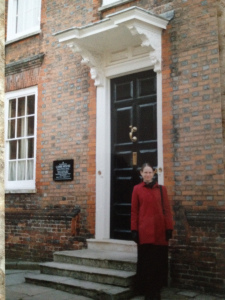
My cousin Honor Lewington took this picture of me at Lamb House, on one of our many “motor-flights” to literary sites in England (inspired by Edith Wharton’s book A Motor-Flight Through France).
I went to Rye once, but my visit was disappointing because Lamb House was closed. I did get to see the house glowering at me, though. Michèle has no photos from her pilgrimage, and she made me promise to include one from my own. I’ve had better luck with visits to The Mount, Edith Wharton’s house in Lenox, Massachusetts, and Jane Austen’s House Museum in Hampshire.
Joy Sussman took some beautiful photographs at The Mount on her visit there a few weeks ago – see her blog post on “Simple Pleasures: All By Myself at Edith Wharton’s House.” You can tour Jane Austen’s House Museum in this entertaining blog post by Karen Doornebos at Jane Austen in Vermont.
Still, I understand the point Michèle makes about “the inevitable discrepancy between our expectations (tempered by our readings) and the real thing.” I wrote a little bit about this idea in my post on “L.M. Montgomery’s Literary Pilgrimage to Concord, Mass.” – do we really think we’ll understand the works better because we’ve seen where they were written? What are we looking for when we visit authors’ houses, and why? 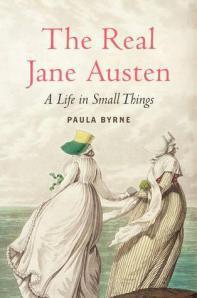
Paula Byrne writes in her uconventional biography The Real Jane Austen (2013) that “Both [Austen’s] world and her novels can be brought alive through the textures of things, the life of objects.” Perhaps in visiting the houses Austen, James, Wharton, and Montgomery lived in, we may catch at least a glimpse of the worlds that inspired their writing, even though, as Michèle writes, we “must reconcile ourselves to the fact that the author’s house will never be a home, no matter how well we think we know it.”
What literary pilgrimages have you made, and what was your experience like?




